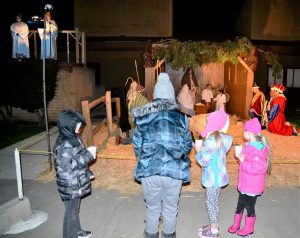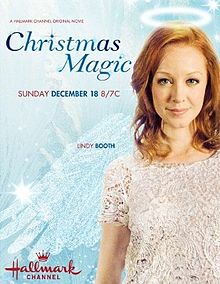
Live Nativity December 2016
“Why do the sheep have to be here?” my eight-year-old grandson, Parker, asks.
I suspect they’re scaring him, even though he and his younger sister are standing behind the three-foot-high barrier between the nativity animals and the audience.
During our visit to a local church’s live nativity the sheep trigger questions from our grandchildren. I ought to be able to answer any questions. After all, my husband and I took our daughters to live nativities for years. It was a Christmas tradition that strengthened our family’s beliefs about the true meaning of Christmas.
In between the narrator’s story, music and characters moving about, I answer my grandchildren’s questions.
“The sheep are here because the shepherds were the first ones the angels told about Jesus’ birth. The shepherds brought their sheep with them to find Jesus in the manger.”
“Why did they take the sheep with them?” Parker asks.
I sense Parker’s hoping the sheep will leave. “The shepherds can’t leave their flocks alone. Their job is to protect the sheep.”
The Narrator adds. “And there were shepherds living out in the fields nearby, keeping watch over their flocks at night. An angel of the Lord appeared to them, and the glory of the Lord shone around them, and they were terrified.”1
Sheep Poop and Shepherds
Six-year-old Khloe tugs my coat sleeve and asks, “Are the sheep real?”
“Yes, they’re real. Look! One just moved his head.”
She inquires, “Do they poop?”
“Yep,” I answer without missing a beat.
“Ucckkk. Smelly,” the grandkids reply in unison.
“It is smelly. The shepherds spend their time in the fields with the sheep so they can’t take a bath very often. They even get poop on them.”
I suspect others hear our discussion as the Narrator’s voice continues, “But the angel said to them, ’Do not be afraid. I bring you good news of great joy that will be for all the people. Today in the town of David a Savior has been born to you; he is Christ the Lord. This will be a sign to you: You will find a baby wrapped in cloths and lying in a manger’” 1
Parker looks down. “I feel sorry for the sheep. Are they cold?”
I assure him, “See the thick wool on their bodies? It’s like your coat – it keeps them warm.”
“But what about their legs?”
Hmmm. That one I can’t answer.
God’s Message
The Narrator concludes the powerful Christmas story. The shepherds “hurried off and found Mary and Joseph, and the baby, who was lying in the manger. When they had seen him, they spread the word concerning what had been told them about this child, and all who heard it were amazed at what the shepherds said to them.” 1
The volunteers provide hot chocolate. We keep warm by the fire. I ask, “What part of the Christmas story did you like best? My favorite part was how God sees every person as special. Even though the shepherds smelled, God thought they were important enough to tell others about Jesus’ birth.”
The grandchildren recount their favorite parts. Even though they giggle again about smelly sheep poop, I know this annual family tradition builds their understanding of the Christmas message. God sent His son to be the Savior of the world.
Thanking the Creator
After we take the grandchildren home, I wonder about the sheep’s legs. I’m intrigued, so I do a couple of searches and learn more about sheep.
Equipped with an understanding of how sheep keep warm, I’m prompted to pray. “Lord, you never cease to amaze me. You create animals with exactly what they need to thrive. The sheep have “thick wool that keeps their body heat in and the cold out. The lanolin in their wool prevents moisture from getting to their skin.” 2 I never knew that when sheep ‘chew their cud’ they are keeping warm. Only You are the amazing creator of every detail.
I come across a prayer that resonates. “Dear Lord, today I rejoice with the shepherds in the Good News of Jesus’ birth. Help me to set aside those traditions that have become commonplace and explore the amazement of Jesus’ birth. Thank You for sending a Savior for me. I want to spend my life sharing this news. In Jesus’ Name, Amen.” 4
What will you do with the angels’ message to the shepherds? “Today in the town of David a Savior has been born to you; he is the Messiah, the Lord.”1
This article was published in Power for Living December 19, 2021.
Sources:
- Luke 2:8-18 All verses NIV from https://www.biblegateway.com/passage/
- How Can Sheep Survive Bitter Cold Weather by Kate. Farm Stay U.S. Posted February 26, 2015. http://www.farmstayus.com/blog/2015/2/26/how-can-sheep-survive-bitter-cold-weather.
- “Winter Sheep Care,” Mary Gessert, DVM. net. http://www.littlehats.net/journeyman/sheep-articles-006.html
- Why God Told Shepherds First, Glynnis Whitwer. Posted December 23, 2010. https://proverbs31.org/read/devotions/full-post/2010/12/23/why-god-told-shepherds-first

 Christmas movies is a popular holiday tradition. Have you seen any good Christmas movies lately?
Christmas movies is a popular holiday tradition. Have you seen any good Christmas movies lately?![ted-the-bear-3-1367103 [freeimages.com]](https://fromdiaperstodiamonds.com/wp-content/uploads/2014/10/ted-the-bear-3-1367103-freeimages.com_-225x300.jpg)

 responsible for actions? “No piggy backing allowed,” says author Dr. Jane Nelson. “Adults piggyback when they lecture, scold, say, ‘I told you so,’ or do anything that adds more blame, shame, or pain than the child might experience naturally from the experience.”1
responsible for actions? “No piggy backing allowed,” says author Dr. Jane Nelson. “Adults piggyback when they lecture, scold, say, ‘I told you so,’ or do anything that adds more blame, shame, or pain than the child might experience naturally from the experience.”1 recognize and name feelings, identify problems, and come up with ideas for solving the problem, and try possible solutions.
recognize and name feelings, identify problems, and come up with ideas for solving the problem, and try possible solutions. certain streets are only one way while others may be closed to thru traffic. Cars and people are re-directed to help the traffic flow better. Re-direct defined is the action of assigning or directing something to a new or different place or purpose.
certain streets are only one way while others may be closed to thru traffic. Cars and people are re-directed to help the traffic flow better. Re-direct defined is the action of assigning or directing something to a new or different place or purpose. Observing the total setting involving students is essential to effective guidance. Proximity: stay close by when younger children are still learning to play together. Keep moving! Activities can change constantly.
Observing the total setting involving students is essential to effective guidance. Proximity: stay close by when younger children are still learning to play together. Keep moving! Activities can change constantly. that they must intervene in every situation which is simply not true. “Adults who work with young children need to develop tolerance for a certain amount of noise, clutter and attention seeking behaviour. As long as children’s activities are not infringing on the rights of others, it is often best to ‘take a breath’, rather than to speak.”1 If you consistently ignore attention-seeking behaviors, they typically stop.
that they must intervene in every situation which is simply not true. “Adults who work with young children need to develop tolerance for a certain amount of noise, clutter and attention seeking behaviour. As long as children’s activities are not infringing on the rights of others, it is often best to ‘take a breath’, rather than to speak.”1 If you consistently ignore attention-seeking behaviors, they typically stop. Focus on specific behavior, rather than on the student. Tell students what they’re doing right. Acknowledge through words and/or gestures.
Focus on specific behavior, rather than on the student. Tell students what they’re doing right. Acknowledge through words and/or gestures.